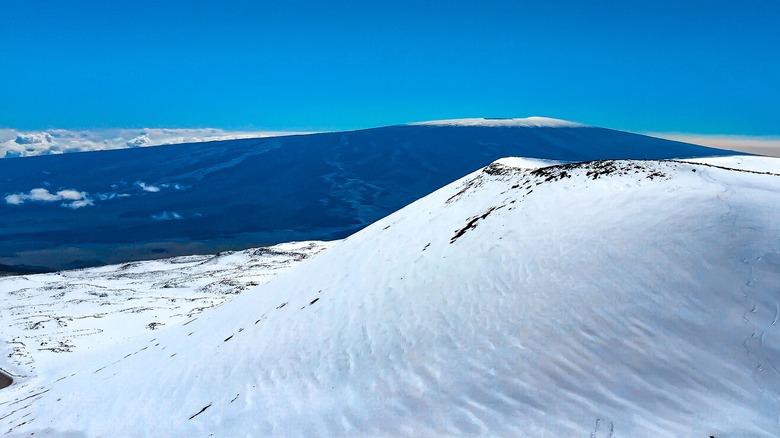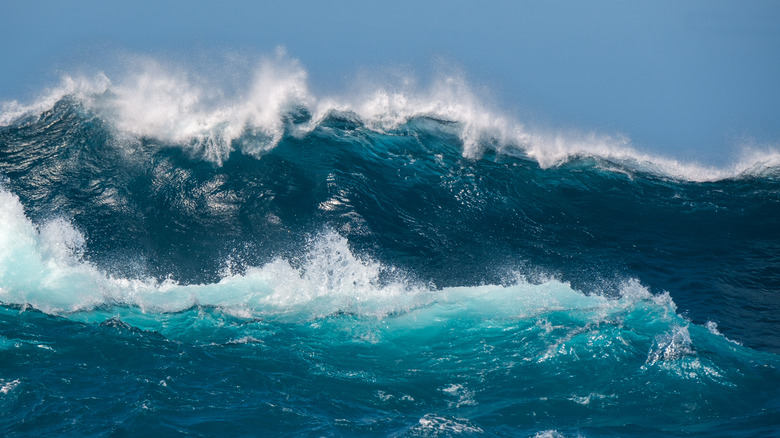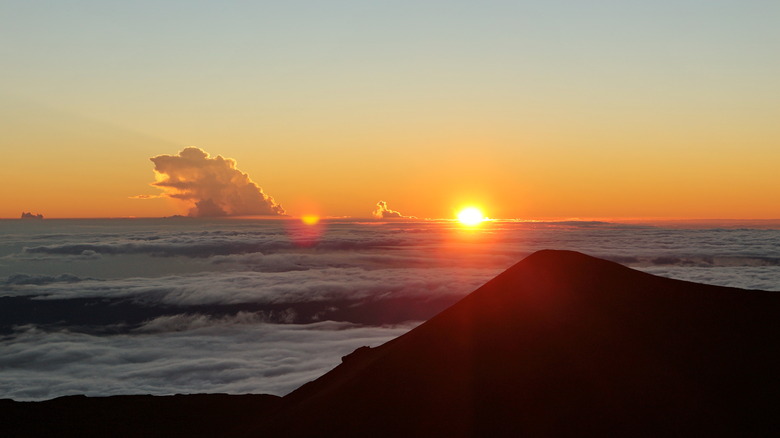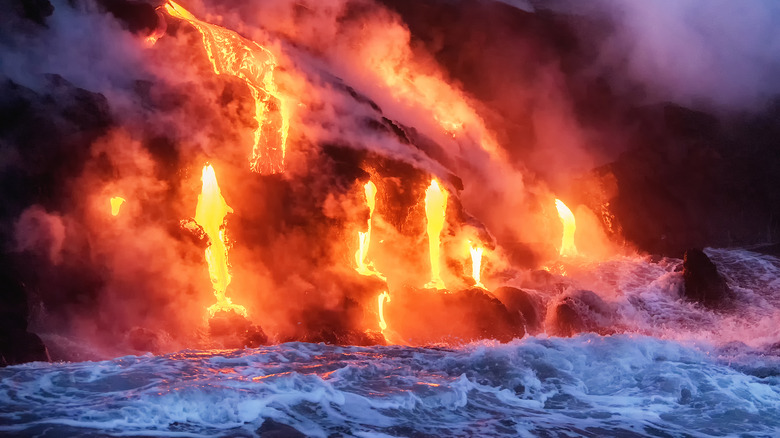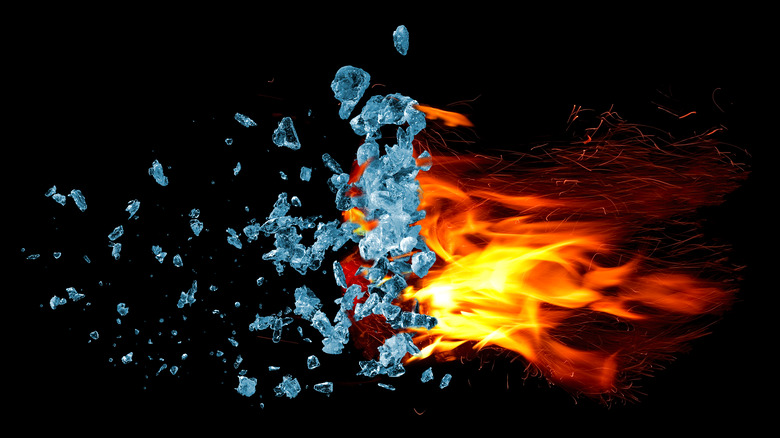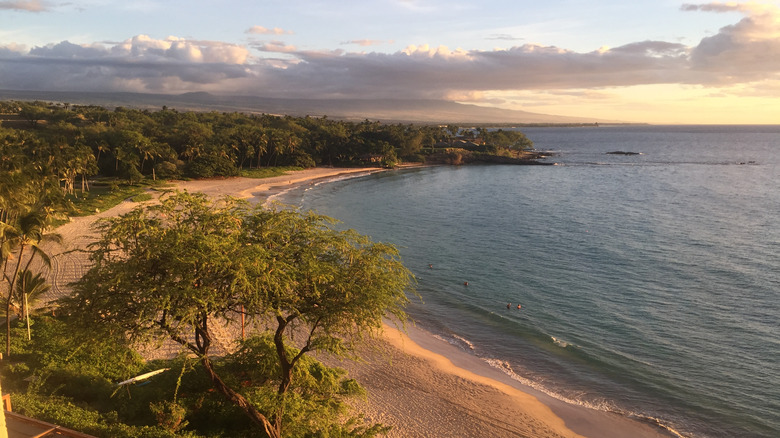In Hawaiian Mythology, The Volcano Of Mauna Kea Is Home To Four Sister Goddesses
One would not expect snow and fire, ice and lava, to exist in one environment. Even less so on a volcano. Mauna Kea, albeit a dormant volcano, was once covered by an ice cap nearly 400 feet thick (via Hawaii Life). This historic Ice Age left its mark on the region, creating unusually coexisting landscapes. And although it's just about 20 degrees from the equator, Mauna Kea is the only place in all of Hawaii that has a permanently frozen layer of ice and soil, known as a permafrost (via University of Hawaii News).
Although scholars take to this theory to explain why one of the most famous tropical destinations in the world has a region that's frozen to its core, native Hawaiians throughout history have had a different explanation. It is believed that four goddesses live on this mountain — the goddess of snow and her younger sisters — while the goddess of fire rages at the mountain's summit. But first, you have to understand the overall story of how the gods created the world, according to Hawaiian legend.
How the Earth was formed
In a time when the Earth was just being formed, the Sky Father (or god) known as Wakea looked down and saw Papa, the Earth Mother (or goddess) (via Hawaii Life). He instantly fell for her beauty, and from their love, the landscapes of Earth were born. Mountains — their children — stretched upwards from Papa's oceans toward their father. Wakea decorated their heads with leis of clouds, while Papa strung seafoam about their necks.
This is just the story of the beginning, but there are many deities in Hawaiian folklore whose stories explain every terrain within the ecologically diverse state. For instance, while scientists believe the conflicting arid and wet climates of the Big Island are caused by the mountains blocking humid, ocean wind from reaching the western side, legend says it was caused by a quarrel between two lovers (via Paradise in Hawaii). As the story goes, the hog god Kamapua'a (who could also call upon the power of storms) had a falling out with his lover, Pele, the goddess of fire (via Coffee Times). While Pele rules dryly from one side of the mountain, Kamapua'a rages with storms, creating lush valleys, on the other. Pele will return later in our story, causing yet another change to the environment with her temper.
The Four Sisters
As for the Four Sisters: there was the goddess of snow, the beautiful Poli'ahu (via Hawaii Life). She is a daughter of Wakea, and it is she who spreads a blanket of white snow at the top of Mauna Kea. During the summer, she wears a pink and gold cloak, blanketing the skyline with beautiful sunsets. While many men have wanted her, she always remained alone, with her three loyal sisters to help guide her. Her little sister Waiau guards her, and is represented by a crater lake on the mountain that is named after her. Her name translates to "water of sufficient depth to bathe," and she was known to help clean her older sister, and keep her hydrated. She also took the form of a bird, to travel about the mountainside fetching things for Poli'ahu.
Another little sister, Kahoupokane, is not only the goddess of the Hualalai volcano, but a master kapa (cloth) maker. Lilinoe, the last sister, is the goddess of mist, which blankets the top of Mauna Kea. The mist represents Poli'ahu's hair, which Lilinoe styles to be so fine it floats about her head, like a cloud. She is also goddess of the dormant Kalekala volcano, dead fires and desolation.
How a rivalry shaped the landscape
The sisters are known to wear white kapa cloaks, sometimes even taking human form to travel about the mountainside (via Hawaii Life). When in their human form, they are said to be gorgeous, intelligent and adventurous. They rule the mountains north of Kilauea, but are said to live in the snowy summits of Mauna Kea. And they have a universal mortal enemy: Pele.
Pele is a Hawaiian volcano deity and the goddess of fire (via National Park Service). She is the creator of volcanic landscapes, and embodies a volcanic temperament herself. She is very strong and competitive, spreading her volcanic fires throughout the land, even near the dormant and snowy Mauna Kea. So you could imagine how Poli'ahu, the goddess of snow, feels about that. In a duel for the ages, Poli'ahu and Pele came together to create the snowy peaks lined by jagged shorelines in the Mauna Kea region, with competing active volcanoes not too far off.
A competition of fire and snow
Along with being the goddess of snow (via Hawaii Life), Poli'ahu was also known to be an incredible, yet competitive, athlete (via Go Hawaii). One of her favorite sports is holua, which involves sledding down her snowy summits at top speeds, to then launch off the mountain into the ocean at the end of the run. Pele, who was known to frequent the base of the mountain, also loved this sport and was equally competitive. Both goddesses were known to sport their human forms to compete with locals, and once, they competed against each other.
Pele is also known to be a beautiful maiden in her human form, and after seeing this one day, Poli'ahu trusted her and invited her to compete. As they sled down the mountain, the ground beneath them grew hotter and hotter, leading Poli'ahu to realize who her competitor was. Caught up in the competition, Pele made the summit erupt with flames, singeing Poli'ahu's snowy peaks. The goddess of snow retreated to protect her lands, while Pele raged below. This rivalry created the Hamakua coast as its seen today — with cliffs and jagged shores — as well as the Laupahoehoe peninsula.
Gods created everything
The region around Mauna Kea, and the jagged shoreline surrounding it, is not the only Hawaiian region with an interesting backstory, competing climates, or deities that dwell within (via Go Hawaii). From the dry and wet sides of the Big Island (via Paradise in Hawaii) where Pele and Kamapua'a infinitely duel (via Coffee Times), to the desserts of Ka'u, the forest of Kohala, or the many beaches sporting black, green or white sands across the state — the snow-capped peak of Mauna Kea fits right in with Hawaii's otherworldly yet coexisting landscapes.
Behind every unexplained mystery that exists along the islands, there is a god or goddess who caused it. While scientists may blame mountain-blocked weather systems or ancient Ice Ages for their influence on the state's landscape, legend speaks of mystical rivalries, magical battles, and a world-building love that could literally move mountains (via Hawaii Life).
